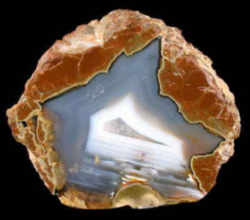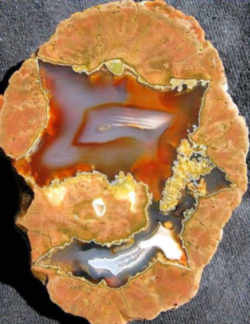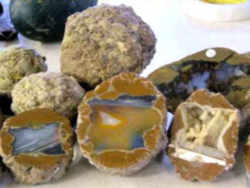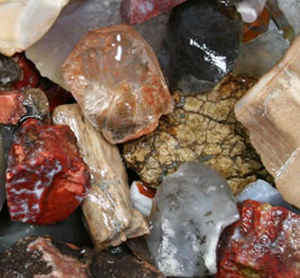Oregon State Rock
Thunderegg
(Nodule or geode occurring in rhyolite, welded tuff, or perlitic rocks.)
Adopted on March 30, 1965.
"Thunder-Eggs" (geode) was designated Oregon's official state rock by the Oregon Legislature in 1965 (Senate Joint Resolution No. 18). Its selection was supported by a 2-to-l vote by members of the mineral and gem clubs of Oregon and by the patrons of the Oregon Museum of Science and Industry (OMSI).
Rockhounds throughout Oregon voted the "Thunder-Egg" as its' first choice for becoming the state rock on March 30, 1965.
Oregon State Rock: Thunderegg
 These rocks range in diameter from less than one inch to over four feet in diameter, and can be found in Crook, Jefferson, Malheur, Wasco, and Wheeler Counties.
These rocks range in diameter from less than one inch to over four feet in diameter, and can be found in Crook, Jefferson, Malheur, Wasco, and Wheeler Counties.
"Thunder-Eggs" are non-descript on the outside, and reveal exquisite designs in a wide range of colors when cut and polished.
Ancient Native American legend dictates when the "Thunder Spirits" living in the highest recesses of snow capped Mount Hood, and Mount Jefferson became angry with one another amid violent thunder and lightning storms, they would hurl masses of these spherical rocks at each other. The hostile gods obtained these weapons by stealing eggs from the Thunderbirds' nests, thus the source of the name "Thunder-eggs." originated.
A Thunderegg is not actually a rock. It is a structure, sometimes a nodule, sometimes a geode, occurring in rhyolite, welded tuff, or perlitic rocks. Thundereggs are spherical masses that range in size from less than an inch to four feet in diameter . Most are about the size of a baseball . They have a knobby rind of drab , siliceous rock and a cavity filled with agate . From the out side they appear nondescript , but when sawed open and polished they may reveal the most exquisite and colorful designs ranging from five-pointed stars to miniature gardens. However, without question, the Thunderegg is by far the most popular "rock" in Oregon.
 Thundereggs were similar to geodes at some point in their creation. That is to say thundereggs were once hollow, to some degree. Thundereggs, like geodes, often form in a subterranean void, such as volcanic gas pocket. Scientists do not agree on the processes forming Thundereggs. Some insist that the characteristic and unique internal pattern of typical Thundereggs is due to expansion and rupture of rock by gases. Others claim the pattern is due to desiccation (drying) of a colloid or gel. Whatever the process, after the cavity that contains the egg is formed, further development is extremely variable in the amount of time needed to complete the egg, degree and type of infilling, and physical characteristics. In large, this solid interior distinguishes the thunderegg from the geode. Typically, an egg has a russet-colored outer shell that is often knobby and often has a characteristic ribbed pattern. Frequently, the inside of the outer shell has a relatively thin intermediate or
transitional lining. This is sometimes composed of an iron or manganese compound, often with a thin coating of opal or chalcedony. Sometimes only opal or chalcedony is apparent. Finally, the center of an egg is usually filled with chalcedony or opal and may or may not have inclusions, pattern growth, or crystals. In some variants, the egg may be hollow or may have a thin layer of chalcedony coating the interior. This layer sometimes is topped with a coating of small quartz crystals.
Thundereggs were similar to geodes at some point in their creation. That is to say thundereggs were once hollow, to some degree. Thundereggs, like geodes, often form in a subterranean void, such as volcanic gas pocket. Scientists do not agree on the processes forming Thundereggs. Some insist that the characteristic and unique internal pattern of typical Thundereggs is due to expansion and rupture of rock by gases. Others claim the pattern is due to desiccation (drying) of a colloid or gel. Whatever the process, after the cavity that contains the egg is formed, further development is extremely variable in the amount of time needed to complete the egg, degree and type of infilling, and physical characteristics. In large, this solid interior distinguishes the thunderegg from the geode. Typically, an egg has a russet-colored outer shell that is often knobby and often has a characteristic ribbed pattern. Frequently, the inside of the outer shell has a relatively thin intermediate or
transitional lining. This is sometimes composed of an iron or manganese compound, often with a thin coating of opal or chalcedony. Sometimes only opal or chalcedony is apparent. Finally, the center of an egg is usually filled with chalcedony or opal and may or may not have inclusions, pattern growth, or crystals. In some variants, the egg may be hollow or may have a thin layer of chalcedony coating the interior. This layer sometimes is topped with a coating of small quartz crystals.
Thundereggs are sometimes found with fortification banding just inside the shell, then an area of horizontal layering, with the remaining central area filled with clear chalcedony or inward-pointing quartz crystals. Banding and layering vary in color, thickness, and content. Some layers are composed of a fibrous cristobalite (lussatite). Other eggs have a partial botryoidal filling of an opal form of low cristobalite. This opal is often fluorescent because of a low content of uranium salts. One collecting site in Oregon has eggs filled with carnelian. At another, the filling may contain cinnabar, which colors it pastel to intense red. Some eggs are filled with pastel jaspers. Others may have any one of a variety of opal fillings that may be opaque blue, opaque red, translucent pastel blue, translucent yellow, translucent red, white, or colorless. Some of the opal can be faceted, and a small percentage is true precious opal.
Some eggs have well-developed calcite crystals encased in chalcedony, and others contain pseudomorphs of chalcedony after calcite. Some eggs have layering that is fanned from one edge, because the egg was rotated by earth movement while the filling was being deposited. This and other features suggest that the complete development of some eggs may have taken considerable time, and the filling-in of the egg may have recorded a series of geologic events. Some eggs contain brecciated rock fragments, while others show faulting, offset, and healing. One of the most unusual Thunderegg variants is up to 3 feet long and 2 to 3 inches in diameter and looks much like a fat gray worm. In some areas, it is common to find the characteristic chalcedony core weathered out of its shell. If a complete egg is sawed in the right orientation, one or more conduits through which filling materials flowed may be found. The beauty and complexities of many of the cut and polished eggs explain why Oregon rockhounds have long been fascinated by Thundereggs.
Oregon Senate Joint Resolution No. 18
Whereas the great and sovereign State of Oregon has a state flag, a state animal (the beaver), a state flower (the Oregon grape), a state bird (the western meadow lark), a state seal, a state tree (Douglas fir) and a state fish (the Chinook salmon); and
Whereas the State of Oregon, being of unbounded international importance as a "rockhound's paradise"; and
Whereas the State of Oregon needs a designated state rock; and
Whereas a number of rock and gem clubs representing all areas of Oregon and the Oregon Museum of Science and Industry have conducted a popular vote to select a state rock; and
Whereas this vote favored the thunderegg two to one; and
Whereas the thunderegg is described as a "remarkable and colorful agate-filled spherical mass of silicified claystone, and rhyolite found throughout the State of Oregon" ranging in size up to four feet in diameter; and
Whereas an old legend of the Warm Springs Indians tells us that these spherical masses were once hurled from the craters of Mt. Hood and Mt. Jefferson when the "spirits of the mountains" were angry and that the "thunder spirits" who lived in the craters hurled the nodules to the accompaniment of much lightning and thunder and therefore the agate-filled nodules became known as "thundereggs"; now, therefore,
Be It Resolved by the Legislative Assembly of the State of Oregon:
That this ancient symbol of geological significance and absorbing native legend, the thunderegg, be acclaimed the Oregon state rock.
Filed in the Office of Secretary of State March 30, 1965.
Oregon Law
The law designating the Thunderegg as the official Oregon state rock is found in the Oregon Revised Statutes Edition, Title 19, Chapter 186
TITLE 19 MISCELLANEOUS MATTERS RELATED TO GOVERNMENT AND PUBLIC AFFAIRS
186. State Emblems; State Boundary
CROSS-REFERENCES.
Thunderegg declared to be official rock, SJR 18 (1965)
Minerals, & Gems

Gemstone, Minerals, Rocks







